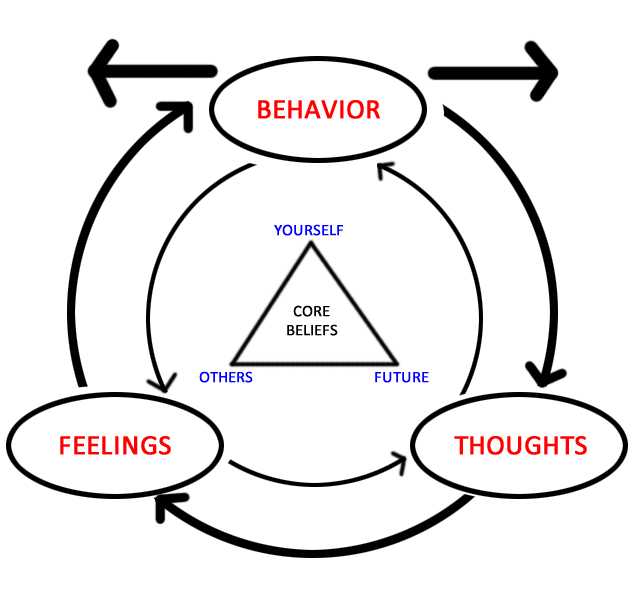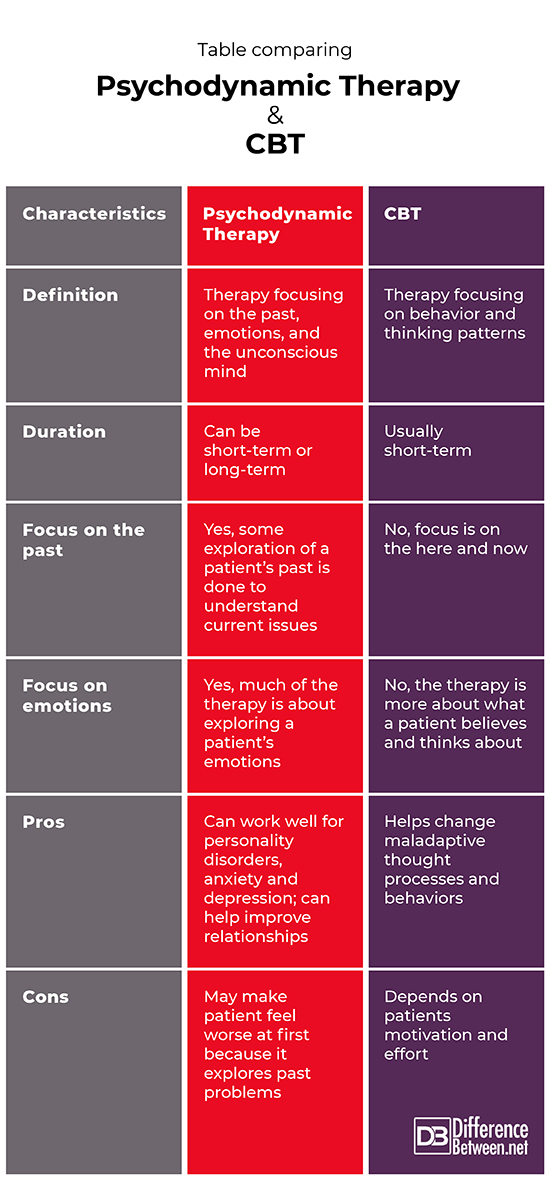Difference Between Psychodynamic Therapy and CBT
Psychodynamic therapy is talk therapy that has a focus on the unconscious mind and emotions, and considers past experiences. CBT is therapy that works on the thinking and behavior patterns that a person has.

What is Psychodynamic therapy?
Definition:
Psychodynamic therapy focuses on how a person’s past and unconscious thoughts can impact present day behaviors. It can be confused with cognitive behavioral therapy, but it does not focus on behavior as much, but rather on emotions. The foundations for psychodynamic therapy are found in psychoanalytic theory, and are related to Freudian ideas and the ego.
Method:
The idea behind this type of therapy is to focus on issues during development, and to examine a patient’s emotions and the unconscious mind. Past relationships and events also provide insight into current issues a patient may be having. The therapy involves talking and it relies on a close relationship being established between the patient and therapist. Psychodynamic therapy can be a short-term process or a long-term form of therapy. Short-term therapy lasts a maximum of 8 months and is about 25 sessions, while long-term therapy lasts longer than 8 months.
Uses:
Psychodynamic therapy can be used to help patients who have struggles with substance abuse, and it is also a common way to treat patients with mental illnesses. People with depression, anxiety, and personality disorders also often benefit from this type of therapy.
Advantages:
Psychodynamic therapy helps patients to better understand their own feelings and why they may act the way they do. The patient is able to gain more confidence and learn a better way to relate to other people, and thus, improve relationships.
Disadvantages:
A drawback of psychodynamic therapy is that it can make a patient feel worse initially, because it explores a patient’s past history and traumas.

What is CBT?
Definition:
Cognitive behavioral therapy or CBT is a short-term type of therapy in which the focus is on helping an individual cope with life challenges through examining patterns of thinking and behavior.
Method:
The method of CBT is focused on learning ways to better cope and overcome maladjusted or poor coping strategies and thought patterns. It is a short-term type of therapy in which there are limited numbers of sessions, ranging from 5 to 20 sessions.
Uses:
CBT can help people learn to cope with stressful events in their life and is also helpful for people who are grieving. A person does not have to have a diagnosed mental illness to benefit from CBT. Similarly to psychodynamic therapy, CBT does work when patients are feeling anxious or depressed.
Advantages:
CBT can be very helpful in aiding people in changing maladaptive and also pessimistic thinking. A further benefit is it gives a person a way to deal with real world problems that they encounter. CBT is a therapy that is often useful regardless of your age, and it can work well with or without medication.
Disadvantages:
The effectiveness of CBT does depend on patient motivation, and if they are willing and eager to put forth the effort to change. There are also often assignments or homework that needs to be done outside of therapy, again meaning a person needs the determination to change and do what they need to. People with severe phobias and also individuals with complicated mental diagnoses may not benefit as much with this type of therapy. It can also make a person initially stressed due to anxiety and worry.
Difference between Psychodynamic therapy and CBT?
Definition
Psychodynamic therapy focuses on the past, emotions, and the unconscious mind. CBT focuses on behavior and patterns of thinking.
Duration
The time it takes for psychodynamic therapy is either short or long-term. CBT, on the other hand, is a short-term type of therapy.
Focus on the past
Psychodynamic therapy aims to help a patient by exploring what happened in their past history. CBT does not dwell on a patient’s past experiences and history.
Focus on emotions
Psychodynamic therapy does have a particular focus on the emotions of the patient. CBT does not focus on the patient’s emotions.
Pros
The pros of psychodynamic therapy are that it is often helpful in treating patients who have personality disorders and various mental health issues. The advantage of CBT is that it helps to change maladaptive thought processes and behaviors.
Cons
A potential weakness of psychodynamic therapy is that a patient may at first feel bad because of exploring past traumas and problems. A weakness of CBT therapy is that it will only be helpful if the patient is determined and motivated to improve.
Table comparing Psychodynamic therapy and CBT

Summary of Psychodynamic therapy Vs. CBT
- Both therapy types help depressed or anxious patients, and can be used along with medication.
- Psychodynamic therapy has a focus on past history and relationships.
- CBT is focused on thought and behavioral patterns that are not working for a patient.
- Difference Between Rumination and Regurgitation - June 13, 2024
- Difference Between Pyelectasis and Hydronephrosis - June 4, 2024
- Difference Between Cellulitis and Erysipelas - June 1, 2024
Search DifferenceBetween.net :
Leave a Response
References :
[0]Andersson, L. A. R. S. "Psychodynamic supervision in a group setting: Benefits and limitations." Psychotherapy in Australia 14.2 (2008): 36.
[1]Leichsenring, Falk, and Eric Leibing. "The effectiveness of psychodynamic therapy and cognitive behavior therapy in the treatment of personality disorders: a meta-analysis." American journal of psychiatry 160.7 (2003): 1223-1232.
[2]Tolin, David F. "Is cognitive–behavioral therapy more effective than other therapies?: A meta-analytic review." Clinical psychology review 30.6 (2010): 710-720.
[3]Image credit: https://commons.wikimedia.org/wiki/File:Depicting_basic_tenets_of_CBT.jpg
[4]Image credit: https://en.wikipedia.org/wiki/File:EtioNosoContinuum.png
